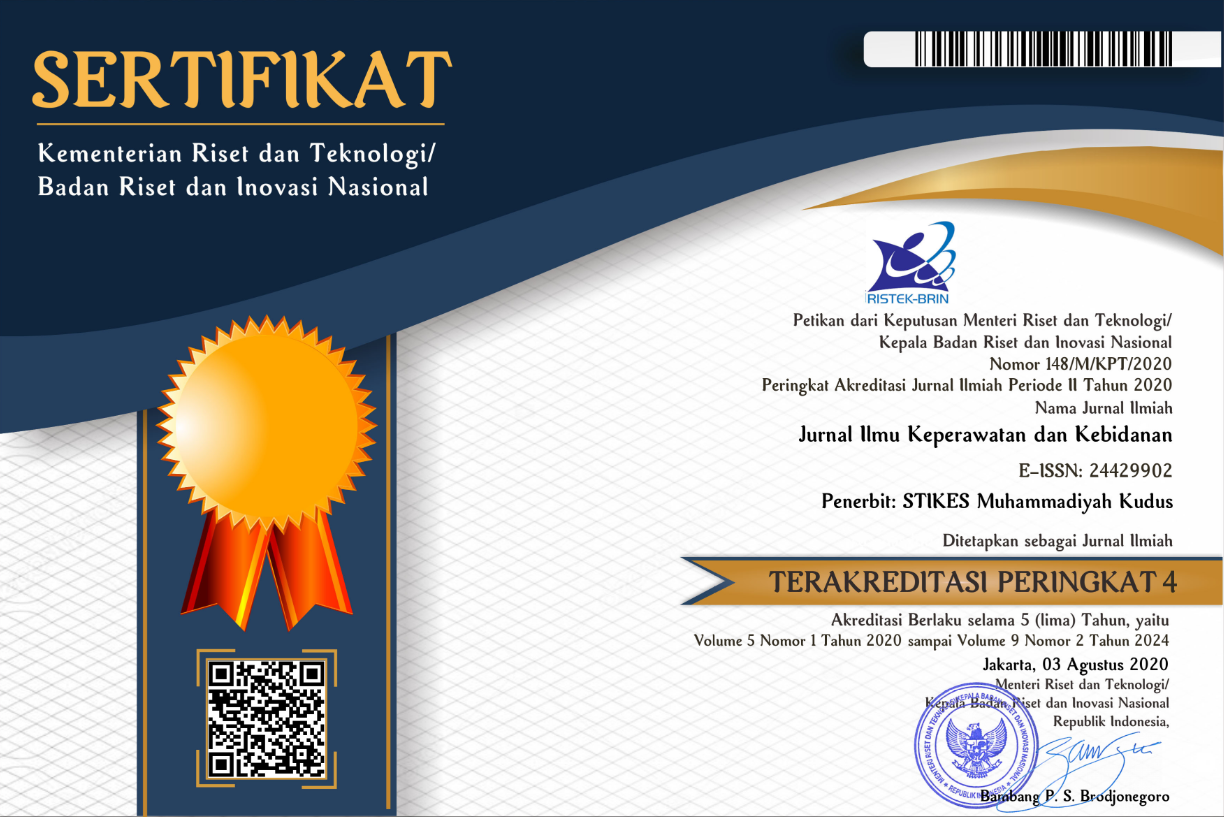HUBUNGAN ANEMIA DAN KURANG ENERGI KRONIK (KEK) PADA IBU HAMIL DENGAN KEJADIAN BERAT BADAN LAHIR RENDAH (BBLR) DI WILAYAH KERJA PUSKESMAS KANDANGAN KABUPATEN TEMANGGUNG
Abstract
Infant mortality rate (IMR) remains a serious issue in Indonesia, and it continues to increase every year. In 2021, Puskesmas (community health center) Kandangan in Temanggung Regency had the second-highest rate of low birth weight (LBW) cases, which was 5.37%, with as many as 38 cases. In addition, there were also two neonatal deaths attributed to LBW. Anemia during pregnancy increases the risk of mothers giving birth to LBW babies due to insufficient hemoglobin, which is essential for oxygen transport and nutrient intake. Furthermore, pregnant women with chronic energy deficiency (CED) suffer from inadequate nutrient intake, which leads to reduced fetal nutrition. This research aimed to investigate the relationship between anemia, CED, and the incidence of LBW among pregnant women in the working area of Puskesmas Kandangan in Temanggung Regency. This research employed analytical observational method with retrospective approach. The population included all live-born infants in the working area of Puskesmas Kandangan in 2022, totaling 657 infants. The researchers employed a 1:1 case- control sampling method, which resulted in 102 samples—51 LBW cases and 51 normal birth weight (NBW) infants as the control group. Data analysis was done using the Chi-square (X2) formula. The findings reveal the relationship between anemia and LBW incidence which has a p-value of 0.006<0.05 and an odds ratio (OR) of 0.324. Similarly, the relationship between CED and LBW incidence has a p-value of 0.002<0.05 and an OR of 0.264. In conclusion, there is a significant relationship between anemia, CED, and LBW incidence among pregnant women. Mothers with anemia are three times more likely to give birth to LBW babies compared to non-anemic pregnant women. Meanwhile, mothers with CED are twice more likely to give birth to LBW babies compared to pregnant women without CED.
Keywords
Full Text:
PDFReferences
Aditianti, A., & Djaiman, S. P. H. (2020). Meta Analisis: Pengaruh Anemia Ibu Hamil Terhadap Berat Bayi Lahir Rendah. Jurnal Kesehatan Reproduksi, 11(2), 163–177.
https://doi.org/10.22435/kespro.v11i2.3799.163-177
Andriani, C.Z, & Masluroh. (2023). Hubungan Anemia dan Kekurangan Energi Kronis (KEK) Pada Ibu Hamila dengan Kejadian BBLR. Journal Research Miwifery, 12(1), 40–47. https://doi.org/10.30591/Siklus.V12i1.4631
Asih, Y., & Imron, R. (2021). Asuhan Kebidanan Kegawatdaruratan Maternal Dan Neonatal. Trans Info Media.
Audrey, H. M., & Candra, A. (2016). Dengan Kejadian Bayi Berat Lahir Rendah Di Wilayah Kerja Puskesmas Halmahera , Semarang. Jurnal Kedokteran, 5(4), 966–971.
Azzizah, elsa nur, Faturahman, Y., & Novianti, S. (2021). Faktor-Faktor yang Berhubungan Dengan Kejadian Bayi Berat Lahir Rendah (Studi di RSUD Dr. Soekardjo Kota Tasikmalaya). Jurnal Kesehatan Komunitas Indonesia, 17(1), 85–98.
BPS Provinsi Jawa Tengah. (2021). Profil Kesehatan Badan Pusat Statistik Provinsi Jawa Tengah.
Darmayanti, L., Sulistiyani, & Ratnawati, L. Y. (2015). Hubungan Antara Status KEK dan Status Anemia dengan Kejadian BBLR Pada Ibu Hamil Usia Remaja (Studi di Wilayah Kerja Puskesmas Cermee Kabupaten Bondowoso) The Correlation Between the Status of Chronic Energy Deficiency and Anemia With Low Birth Weight (LB. Artikel Ilmiah Hasil Penelitan Mahasiswa.
Dinas Kesehatan Kabupaten Temanggung. (2019). Rencana Strategi Dinas Kesehatan Kabupaten Temanggung Tahun 2019-2023.
Riskesdas Kabupaten Temanggung 2019-2023, 135.
Dinas Kesehatan Provinsi Jawa Tengah. (2019). Profil Kesehatan Provinsi Jateng Tahun 2019. Dinas Kesehatan Provinsi Jawa Tengah, (24), 61.
Fatimah, S., & Yuliani, N. T. (2019). Hubungan Kurang Energi Kronis (Kek) Pada Ibu Hamil Dengan Kejadian Berat Bayi Lahir Rendah (BBLR) Di Wilayah Kerja Puskesmas Rajadesa Tahun 2019. Journal of Midwifery and Public Health, 1(2). https://doi.org/10.25157/jmph.v1i2.3029
Haryani., Hardiani, S., & Thoyibah, Z. (2020). Asuhan Keperawatan Pada Bayi Dengan Risiko Tinggi. Trans Info Media.
Haryanti, S. Y. (2019). Anemia Dan Kek Pada Ibu Hamil Sebagai Faktor Risiko Kejadian Bayi Berat Lahir Rendah (Bblr) (Studi Di Wilayah Kerja Puskesmas Juwana Kabupaten Pati). Jurnal Kesehatan Masyarakat (e-Journal), 7(1), 322–329.
Kemenkes RI. (2021). Profil Kesehatan Indonesia. In Pusdatin.Kemenkes.Go.Id.
Manuaba, I. B. S. (2012). Ilmu Kebidanan, Penyakit Kandungan, Dan KB. EGC.
Novianti, S., & Aisyah, I. S. (2018). Hubungan Anemia Pada Ibu Hamil Dan BBLR. Jurnal Siliwangi, 4(1).
Nur, A. F. (2020). Anemia Dan Kejadian Berat Badan Lahir Rendah Di Rumah Sakit Umum Anutapura Palu. Ghidza: Jurnal Gizi Dan Kesehatan, 2(2).
Permenkes. (2022). Peraturan Menteri Kesehatan Republik Indonesia nomor 42 (2022). Menteri Kesehatan Republik Indonesia Peraturan Menteri Kesehatan Republik Indonesia, 879.
Proverawati, A. (2018). Anemia Dan Anemia Kehamilan. Nuha Medika.
Rahadinda, A., Utami, K. D., & Reski, S. (2022). Hubungan Anemia pada Ibu Hamil dengan Kejadian BBLR di RSUD Abdul Wahab Sjahranie Samarinda. Formosa Journal of Science and Technology, 1(5).
Rahmah, N., & Karjadidjaja, I. (2020). Hubungan anemia pada ibu hamil terhadap kejadian berat badan lahir rendah (BBLR) di Puskesmas Kecamatan Pasar Rebo Jakarta Timur. Tarumanagara Medical Journal, 3(1), 174–179.
Rahfiluddin, M., Cynthia Putri, H., & Siti Fatimah, P. (2017). Faktor – Faktor yang Berhubungan dengan Kejadian Berat Badan Lahir Rendah (BBLR) Di Kabupaten Kudus (Studi di Wilayah Kerja Puskesmas Undaan Kecamatan Undaan Kabupaten Kudus Tahun 2015). Jurnal Kesehatan Masyarakat (e-Journal), 5(1).
Ridha, N. H. (2014). Buku Ajar Keperawatan Anak. December, 293–296.
Safitri, D., Kek, K., & Kejadian, D. (2019). Hubungan Paritas, Anemia dan Kekurangan Energi. 13(25), 15–21.
Sari, H., Yarmaliza, & Zakiyuddin. (2022). Faktor-faktor yang Mempengaruhi Kejadian Anemia Pada Ibu Hamil di Wilayah Kerja Puskesmas Samadua Kecamatan Samadua Kabupaten Aceh Selatan. Jurmakesmas, 2(1), 133–147.
Sembiring, & Julina Br. (2019). Asuhan Neonatus, Bayi, Balita, Anak Prasekolah. Deepublish.
Sumiati, Suindri, N., & Mauliku, J. (2021). Hubungan Kurang Energi Kronik pada Ibu Hamil dengan Bayi Berat Lahir Rendah. Info Kesehatan, 11(2), 360–366.
Sumiaty, & Restu, S. (2016). Kurang Energi Kronis (KEK) Ibu Hamil Dengan Bayi Berat Lahir Rendah (BBLR). Jurnal Husada Mahakam, IV(3), 162–170.
Syukur, N. abdul. (2017). Faktor – Faktor Yang Menyebabkan Kurang Energi Kronis (KEK) Pada Ibu Hamil di Puskesmas Sidomulyo Kota Samarinda. Mahakam Midwifery Journal, 1(1), 146–154.
Wahyuni, R., Rohani, S., & Ayu, juwita desri. (2022). Hubungan Kekurangan Energi Kronik (KEK) dengan Kejadian Bayi Berat Lahir Rendah (BBLR) di Praktik Bidan Mandiri (PMB) Desti Mayasari Pekon Kedaung Kecamatan Pardasuka Tahun 2022. Jurnal Maternitas Aisyah, 9–11.
WHO. (2017). Constitution of WHO: principles. WHO.
Winarsih. (2018). Pengantar Ilmu Gizi Dalam Kebidanan. Pustaka Baru Pers.
DOI: https://doi.org/10.26751/jikk.v15i1.2135
Refbacks
- There are currently no refbacks.
Universitas Muhammadiyah Kudus - LPPM Universitas Muhammadiyah Kudus
Jl. Ganesha 1 Purwosari Kudus 59316
Tel/ Fax +62-291-437218 Email : [email protected]
Jurnal Ilmu Keperawatan dan Kebidanan Indexed by:

This work is licensed under a Creative Commons Attribution-ShareAlike 4.0 International License.













